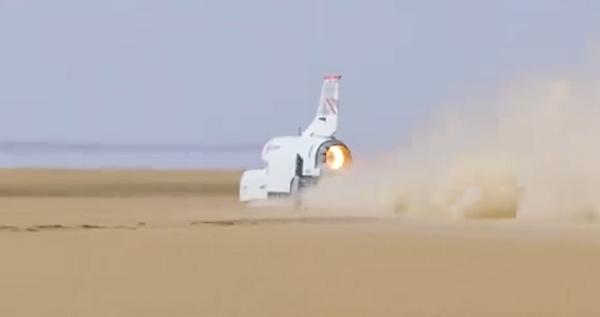
That’s the insane question that the average driver assessing the thrill spectrum of the roadways ranging from ultra-defense to radical Evil Kenevil, wishes to avoid. However, the adrenaline junkies of the extreme test pilot community of the near supersonic speeds flashing across the vast expansive natural proving grounds of salt flats and deserts, prefer the interface with a Rolls-Royce euro jet engine jerry-rigged and welded to a modified a formula class race car suspension.
Meet the Bloodhound LSR, a distant relative to a sleek speed merchant of a rocket shaped dagger on wheels, built to slash through any terrestrial air resistance with the cold-blooded indifference of a space missile carving up cosmic matter, while owning earth’s gravity well. Actually, the vehicle morph is a robust and deft engineering achievement facilitated the efforts of a British research team, and dimly resembles the vision of a sporty aesthetic mechanism, the abundance of precise glistening lines that pulsate with a primal instinct illustrating the fundamental concept of blazing fast absent and entirely decadent and incongruent in legitimizing a rugged quest to reach the rarified air of the record books.
At 42 feet in length, 8 feet wide and weighing just over 7 tons at full fuel capacity, the Bloodhound was designed and built for an estimated cost of $23 million.
The unlikely fusion of the aviation and racing technology combined with DIY applied goodness assaults the already diminutive survivability odds, a lurking danger that is deliciously invigorating when weighing the plausibility of shattering land speed world records. The UK-based project has already exceeded 628 mph with a goal of breaking the sound barrier, before exceeding 1,000 mph. Lofty figures for a competitive innovative venture where success is contingent on the proportional three way intersection of funding, mechanical performance, and driver skillset.
Everything was not always roses for the land craft named after a reliable detective dog. In 2018, the initial attempt at forwarding research and performance nearly fizzled out as a result of glaring financial issues even before boosters and engineers could being to dream of the vehicle evolving into a viable threat capable of targeting the most ambitious of speed milestones. At one point the test vehicle was offered at $313 thousand dollars as part of a desperate plea in securing the necessary capital to sustain operations.
The question remains, how does one execute a turn when operating a racecar-solar system transport hybrid in the arid wilds of desolate stretches of nothingness scattered throughout the western US, Australia, and South Africa? Or for that matter how does the test driver ensconced in brevity avoid disintegrating into a glorious explosion of flames and a trail of debris? The answer is, there is none, or at least a cogent tidbit of reasoning that does not involve at least some form of prayer.
—
This jet-car powered by Duckduckgo.com